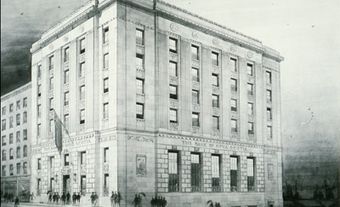Institutionalized banking came to British North America in 1820, when the Bank of New Brunswick at Saint John was granted a charter by the provincial government. In 1822 the Bank of Montreal, in operation since 1817, was chartered by the Province of Lower Canada. By year's end, there were 5 chartered banks in the provinces; on the eve of Confederation, there was a total of 28 in the provinces of Canada, NS and NB.
In 1818 the Bank of Montreal constructed a stolid 3-storey building on rue St-Jacques on the model of a Georgian townhouse with a small porch consisting of a classical pediment supported by Doric columns. The Bank of Upper Canada on Toronto's Adelaide St East (W.W. Baldwin, 1825-27) also resembled a respectable London townhouse with a Doric portico added in 1843.
The Bank of New Brunswick (c 1826) in Saint John, NB, made a bolder statement, erecting a neoclassical building whose façade consisted simply of an Ionic temple front, closely following the innovative example of the Second Bank of the United States, Philadelphia (William Strickland, 1818-24). These buildings established the image of the bank as a temple of finance. The facilities typically included a public banking hall and offices for the bank's operations.
Classical variants persisted as the century progressed. Montréal's rue St-Jacques was the financial heart of Canada where stood the neoclassical second Bank of Montreal (John Wells, 1845-48), the mansion-like Italian Renaissance Revival Molsons Bank (George Browne, 1864-66) and the Second-Empire Merchants Bank of Canada (Hopkins and Wily, 1870).
Other cities followed MontrŽal's lead. In Toronto, the Greek Revival Commercial Bank of the Midland District (William Thomas, 1843-45) and the Second-Empire Bank of British North America (Henry Langley, 1871-73) shifted the banking centre to Yonge Street.
Less frequently, nonclassical styles appeared, such as the Richardsonian Romanesque west end branch of the Bank of Montreal in Montréal (Taylor and Gordon, 1889).
The construction of impressive bank buildings in Winnipeg early in the 20th century proclaimed that the prairie city had achieved a dominant financial position. The many imposing banking structures around Portage Ave and Main St favoured Beaux-Arts classicism; they included the Bank of Montreal (McKim, Mead and White, 1913) and the Canadian Bank of Commerce (Darling and Pearson, 1910), the 10-storey Bank of Hamilton Building (J.D. Atchison, 1916), and the smaller but sophisticated Bank of Toronto (H.C. Stone, 1906) and Royal Bank of Canada (Carrère and Hastings, 1910). All featured superb banking halls.
Branch banking had been legalized in 1841, and by 1900 there was a proliferation of branch operations, with head offices (and profits) concentrated in Toronto, Montréal and Halifax. Many branches were designed from a central office. In order to remain competitive in the rapidly expanding West, the Canadian Bank of Commerce hired the Toronto firm of Darling and Pearson to design prefabricated branches. Between 1906 and 1910 the B.C. Mills Timber and Trading Co produced almost 70 structures in 3 sizes. Shipped from Vancouver by rail to their destination, they could be erected in a single day. For example, the Canadian Bank of Commerce in Crossfield, Alberta, was built on 17 April 1906.
Mortgage loan companies and trust companies, which were formerly separate from chartered banks, generally followed the banks' classical model. The BC Permanent Loan Company (Hooper and Watkins, 1907) in Vancouver is a relatively small but well-designed temple design; its image was sufficient for the Bank of Canada to occupy it from 1935 to 1966. credit unions and caisses populaires, in contrast, preferred a more populist and less elitist image and so often resembled retail stores.
Architect John M. Lyle designed both large and small banks for the Bank of Nova Scotia in the 1920s and 1930s. The Bank of Nova Scotia (1924) on Sparks St, Ottawa, with its free-standing columns and decorated frieze on the second floor, set above a rusticated base, represents the height of Lyle's classical bank designs. Lyle's similarly composed Bank of Nova Scotia (1929-30) in Calgary is far flatter, with incised decoration, revealing streamlined modernist tendencies within a neoclassical vocabulary.
From Image to Efficiency
After 1945 major changes occurred in the attitude of banks toward their buildings, as reputations established in the preceding decades removed the need to be identified by impressive, symbolic architecture. Efficiency became paramount as the policy of centralized, standardized design intensified. Old branches were judged obsolete and replaced with new ones designed by the banks' architectural staffs. Each bank had its preferred material - the Banks of Commerce and Montreal chose brick, and the Royal Bank black granite. Most were single-storey, plain, rectangular structures. In contrast to the era when banks dominated their surroundings, standing as the symbols of a town's sense of wealth and worth, post-War branch banks are frequently understated buildings, striving to express themselves as part of the community.
National and regional head offices have continued the tradition of assertive design. Beginning in the 1960s, a number of banks occupied large portions of distinguished high-rise towers in the international style. Most noteworthy are the Toronto Dominion Centre in Toronto (L.M. van der Rohe, with John B. Parkin Associates, and Bregman and Hamann, 1963-69), originally two towers and a low banking pavilion, but now expanded to five towers; the Royal Bank in Montréal's Place Ville Marie (I.M. Pei and Associates, with Affleck, Desbarats, Dimakopoulos, Lebensold, Michaud and Sise, 1958-66); and Royal Bank Plaza, Toronto (Webb Zerafa Menkès Housden Partnership, 1972-76), which features a stunning atrium.
This new architectural image of the 1960s and '70s often came at the expense of the earlier 19th- and 20th-century bank buildings. In order to clear the six-acre site at King and Bay Streets in Toronto for Mies van der Rohe's TD Centre, the former Beaux-Arts head office of the Bank of Toronto (Carrere and Hastings, 1911-13) was demolished in 1966.
Other banks added to, rather than replaced, their earlier landmarks, showing increasing respect for heritage conservation. The tall art deco headquarters of the Canadian Bank of Commerce in Toronto (York and Sawyer, with Darling and Pearson, 1929-31) was augmented in 1968-72 with the taller (57-storey) Commerce Court (I.M. Pei with Page and Steele). The Bank of Canada, the regulator of the nation's money, has enlarged its original headquarters, a masterpiece of modern classicism (Marani, Lawson, and Morris, with S.G. Davenport, 1937), by wrapping the building with twin 12-storey towers of mirrored glass (Arthur Erickson, with Marani, Rounthwaite and Dick, 1974-79). The Bank of Montreal in Winnipeg expanded its 1913 building with a slender 22-storey granite-faced tower (Smith Carter Partners, 1982-84) that succeeds in respecting the historic structure.
Developments
The recent liberalization of banking regulations has enabled banks to offer increased services, including trust services and sales of securities, and this has led in turn to mergers with trust companies and brokerage firms. At the same time, the introduction of electronic banking has enabled online banking and caused a proliferation of automatic bank machines (ABMs), many in non-bank locations, thereby reducing the need for personal visits to the bank for deposits and withdrawals. The new financial institutions have responded with name changes (for example, eliminating the word "bank"), the closure of redundant branches, and interior alterations and/or additions to ongoing branches that provide more offices for private meetings and counters that are suited to electronic transactions. Indeed, some newer financial institutions, such as ING Direct, do not occupy any buildings; clients complete all transactions online or over the phone. The sale of redundant bank buildings has led to numerous examples of creative adaptive reuse.
See also Urban Design.

 Share on Facebook
Share on Facebook Share on X
Share on X Share by Email
Share by Email Share on Google Classroom
Share on Google Classroom



